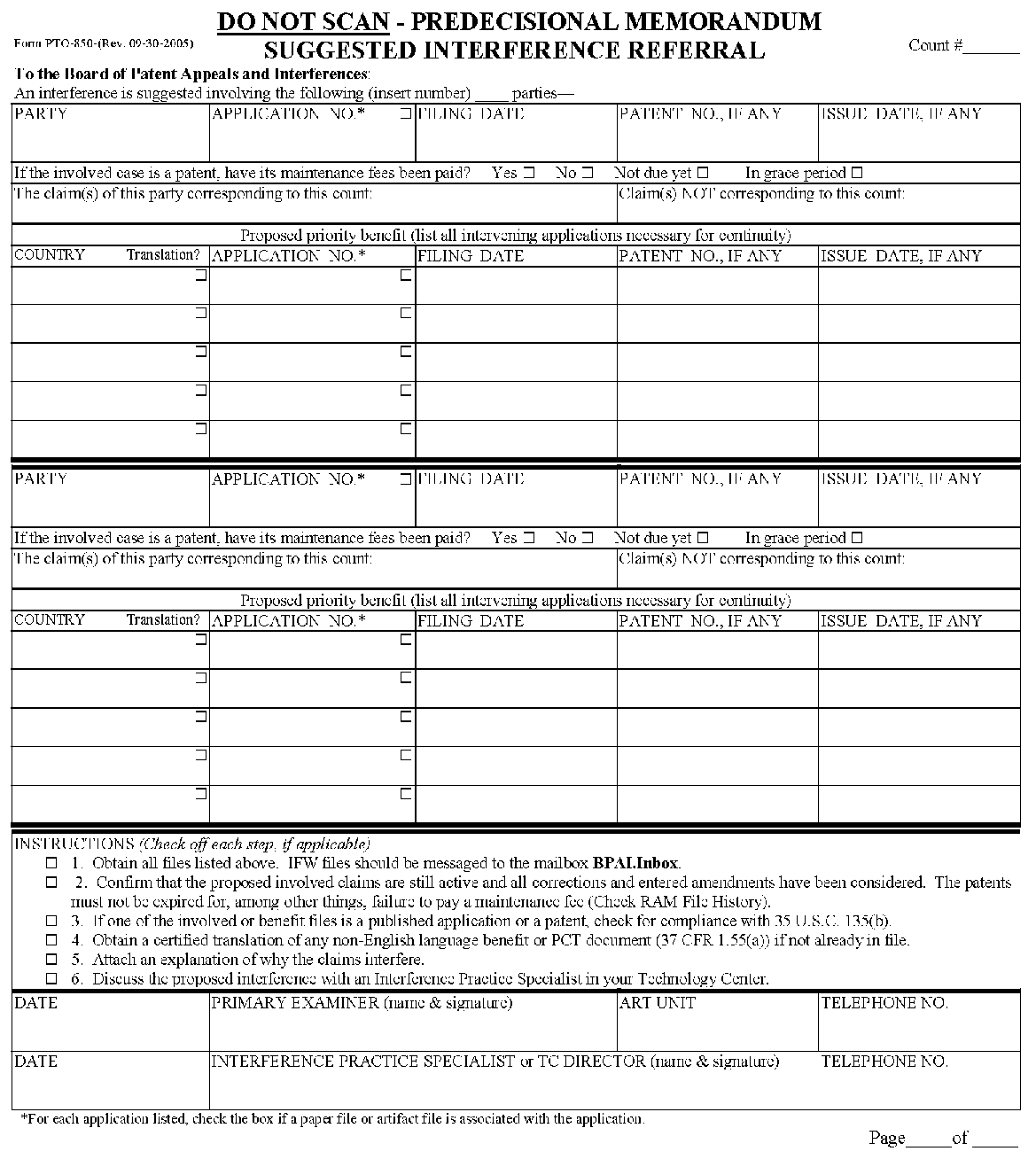Notice regarding Section 508 of the Workforce Investment Act of 1998. Section 508 of the Workforce Investment Act of 1998 requires all United States Federal Agencies with websites to make them accessible to individuals with disabilities. At this time, the MPEP files below do not meet all standards for web accessibility. Until changes can be made to make them fully accessible to individuals with disabilities, the USPTO is providing access assistance via telephone. MPEP Interim Accessibility Contact: 571-272-8813.
2302 Consult an Interference Practice Specialist [R-4] - 2300 Interference Proceedings
2302 Consult an Interference Practice Specialist [R-4]
Every Technology Center (TC) has at least one Interference Practice Specialist (IPS), who must be consulted when suggesting an interference to the Board of Patent Appeals and Interferences (Board).
Less than one percent of all applications become involved in an interference. Consequently, examiners are not expected to become experts in interference practices. Instead, examiners are expected to be proficient in identifying potential interference and to consult with an IPS in their TC on interference matters. The IPS, in turn, is knowledgeable about when and how to suggest interferences, how to handle inquiries to and from the Board before and during interferences, and how to handle applications after interferences are completed.
An IPS must approve any referral of a suggested interference to the Board. The referral must include a completed Form PTO-850, which either an IPS or a Director of the examiner's TC must sign.
IPSs consult with administrative patent judges (APJs) that declare interferences to stay current in interference practice. When necessary, an IPS may arrange for a consultation with an APJ to discuss a suggested interference or the effect of a completed interference. Examiners must promptly address inquiries or requests from an IPS regarding a suggested interference.

GENERAL PRACTICES
Practice 1. Consult an Interference Practice Specialist.
In an effort to maximize uniformity, when an examiner first becomes aware that a potential interference exists or any other interference issue arises during prosecution of an application, the examiner should bring the matter to the attention of an IPS in the examiner's TC.
The IPS in turn will consult with an APJ designated from time to time by the Chief Administrative Patent Judge.
A plan of action will be developed on a case-by-case basis.
Practice 2. Party not in condition for allowance.
When:
(A) a first application and a second application claim the same patentable invention; and
(B) a first application is in condition for allowance; and
(C) the second application is not in condition for allowance,
then generally a notice of allowance should be entered in the first application and it should become a patent.
Without suspending action in the first application and after consultation consistent with Practice 1 above, the examiner may wish to give the second applicant a very brief period of time within which to put the second application in condition for allowance, e.g., by canceling rejected claims thereby leaving only allowable claims which interfere with the claims of the first application.
When examination of the second application is complete, an application versus patent interference may be appropriate.
Practice 3. Both in condition for allowance; earliest effective filing dates within six months.
When two applications are in condition for allowance and the earliest effective filing dates of the applications are within six months of each other, an application versus application interference may be suggested, provided the applicant with the later filing date makes the showing required by 37 CFR 41.202(d). Note that if the earliest filed application is available as a reference (for example, as a published application under 35 U.S.C. 102(e)) against the other application, then a rejection should be made against the other application. Ideally, the rejection would be made early in the prosecution, but if it is not and as a result the junior application is not in condition for allowance, then the senior application should be issued. In light of patent term adjustments it is no longer appropriate to suspend an application on the chance that an interference might ultimately result.
Practice 4. Both in condition for allowance; earliest effective filing dates not within six months.
If the applications are both in condition for allowance and earliest effective filing dates of the applications are not within six months of each other, the application with the earliest effective filing date shall be issued. The application with the later filing date shall be rejected on the basis of the application with the earliest effective filing date. Further action in the application with the later filing date will be governed by prosecution in that application. If the applicant in the application with the later filing date makes the showing required by 37 CFR 41.202(d), an application versus patent interference may be declared. If no rejection is possible over the patent issuing from the application with the earliest effective filing date, then the applicant must still be required under 35 U.S.C. 132 to make the priority showing required in 37 CFR 41.202(d).
Practice 5. Suspension discouraged.
Suspension of prosecution pending a possible interference should be rare and should not be entered prior to the consultation required by Practice 1 above.<
>